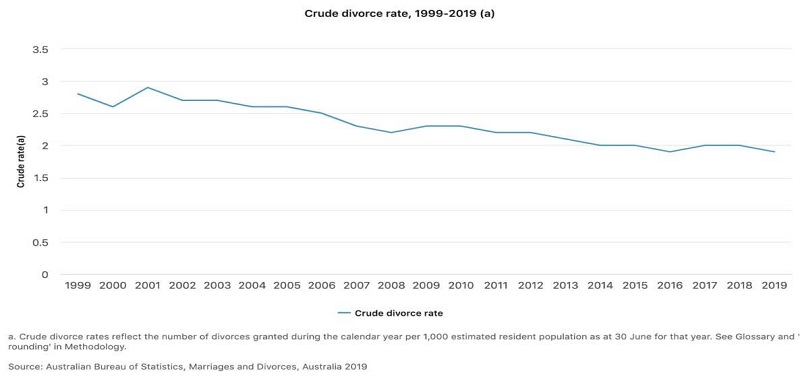The Effect of COVID-19 on Divorce Rates and Logistics
“Widespread outbreaks of infectious diseases such as pandemics lead to widespread outbreaks of fear.” – Taylor, S. (2021). COVID Stress Syndrome: Clinical and Nosological Considerations.
Introduction
In Australia, divorce is “the formal legal ending of a marriage,” available when the parties can show that their marriage has “irretrievably broken down” (Family Relationships Online, para. 1). It frees both parties to remarry and move on with their lives after a marital breakdown. There are many contributing factors to divorce, including tension, incompatibility, infidelity, and abuse. Covid-19 and the forced proximity of the numerous worldwide lockdowns have exacerbated these issues (Smyth et al., 2020). The global pandemic caused by SARSCov2 (Covid-19) is the first event of its kind in decades. The uncertainty and rapidly evolving global situation mean that the research in this area is still ongoing. Despite this, it is clear that the presence of this virus is negatively affecting the health, both mental and physical, of the majority of the population, and it appears that this will continue to be a long-term issue (Taylor, 2021.)
Divorce Trends Pre-Covid 19
Prior to Covid-19, the public perception was that global divorce rates were on the rise. This has been attributed to a number of causes, including modernisation and large-scale socio-cultural changes (Wagner, 2020). Part of this is that the divorce rate increased as the stigma around divorce decreased, and barriers to getting a divorce disappeared. This includes the No Faults divorce introduced in Australia in the 1980s.
Although this trend of divorces increasing did happen in the latter half of the 20th Century, it appears that the rate of divorce has decreased in recent years. The crude divorce rate in Australia has dropped from 2.8 per 1,000 in 1999 to 1.9 per 1,000 in 2019 (Australian Bureau of Statistics, 2020).

Divorce Trends During/Post Pandemic
The situation with Covid-19 is unprecedented, but the research that has already been done indicates that the divorce rates will increase. This rise in divorce was predicted as early as June 2020 (Kashino, 2020), and the statistics so far support this. Anecdotal evidence from several countries (including China, Canada, and the USA) suggests that the number of couples seeking separation or divorce is increasing as a result of Covid-19 (Smyth et al., 2020).
Lockdown, particularly being stuck together in a small space, is causing increases in overall tension and stress among families. General uncertainty about the future (on both an individual and global scale) adds to this stress.
This has exacerbated such a broad range of mental health issues that experts are now considering an entirely new disorder- Covid Stress Syndrome (CSS) (Taylor, 2021). This Syndrome includes fear of contamination, socio-economic impact, and pandemic-related compulsive behaviours and trauma symptoms. All of these issues, even when not considered a diagnosable condition, put more strain on relationships.

The Covid-19 pandemic has also caused logistical difficulties with separated families; with travel between households becoming illegal for periods of time, childcare arrangements can be difficult. One example of this is changing financial situations affecting child support payments, which can be difficult to deal with at the best of times (Smyth et al., 2020). There are also safety issues if multiple families are mingling out of necessity, as in shared parenting cases. This causes different families to have to travel and interact during the lockdown and can result in potential breaches of public health orders. One person breaking these rules could endanger multiple families indirectly. This is also an issue in cases of infidelity. One woman in June of 2020 reported that her husband was seeing another woman, and she was concerned about the risk of him catching Covid-19 and bringing it back to their family (Kashino, 2020). As well as this, some couples are unable to separate due to travel and movement restrictions. Some spouses broke up at the start of the pandemic, but lockdown started before either could move out. This has caused them to be “stuck” with each other for the duration of the lockdown (Kashino, 2020), exacerbating the usual stress of a separation and leading to further family breakdown.
In addition to these problems, the pandemic-induced strain on resources has reduced people’s access to legal remedies, including mediation, divorce courts, and family courts. Many divorce courts are unable to hear cases for anything less than domestic violence, as the sheer number of people experiencing “run of the mill marital woes” is overloading the system (Kashino, 2020, p. 4). Divorce lawyers have heavy caseloads and are dealing with completely new issues, such as helping a couple organise custody arrangements while living separately in the same house (Kashino, 2020). Many people are also seeking relationship advice and being more cautious about entering new relationships (“Divorce in the Age of Covid”, 2021). These new issues, as well as accessibility problems caused by lockdowns, have led to an increase in online services being offered. This includes all manner of Zoom legal advice and mediation, as well as non-judicial remedies such as couples counselling or therapy for children of divorce (Smyth et al., 2020). These online resources have quickly changed from last resort measures to, in many cases, the only resources available.
Conclusion
It cannot be denied that the Covid-19 pandemic has affected divorce in Australia and internationally. Though the situation is still evolving, a significant amount of research reflects this already. In 2021, a year on from the initial global panic, we are starting to see some of the long-term effects of living in the shadow of disease. The pandemic is causing more stress about lockdowns, finances, and the threat of illness and death. These stressors, along with simply being stuck together with someone twenty-four hours a day, are resulting in increased rates of separations and divorces. This surge is causing logistical difficulties both in terms of the actual process, as the court system is overloaded, and in terms of how to deal with the situation afterward with splitting custody, moving out of the house, and organising finances. It appears that these issues will continue for as long as the intermittent lockdowns do and will have long-lasting effects well beyond this time.
References
- Australian Bureau of Statistics (2020) Marriages and Divorces, Graph 7. Crude Divorce Rate, 1999-2019.
- Divorce in the age of COVID. (2021, January 19). Long Island Business News, NA. https://link.gale.com/apps/doc/A649543051/ITOF?u=dixson&sid=bookmark-ITOF&xid=3894f72e
- Family Relationships Online: Helping Families Build Better Relationships (n.d.). Going through separation (Divorce). Australian Government Initiative. Retrieved from: https://www.familyrelationships.gov.au/separation/divorce
- Kashino, M. (2020). The Covid Divorces Are Coming. The Washingtonian (Washington, D.C.), 55(9), 60.
- Smyth, B.M., Moloney, L.J., Brady, J.M., Harman, J.J. and Esler, M. (2020), COVID-19 in Australia: Impacts on Separated Families, Family Law Professionals, and Family Courts. Family Court Review, 58: 1022-1039. https://doi.org/10.1111/fcre.12533
- Taylor, S. (2021). COVID Stress Syndrome: Clinical and Nosological Considerations. Curr Psychiatry Rep 23. https://doi.org/10.1007/s11920-021-01226-y
- Wagner M. (2020) On Increasing Divorce Risks. In: Mortelmans D. (eds) Divorce in Europe. European Studies of Population, vol 21. Springer, Cham. https://doi.org/10.1007/978-3-030-25838-2_3






